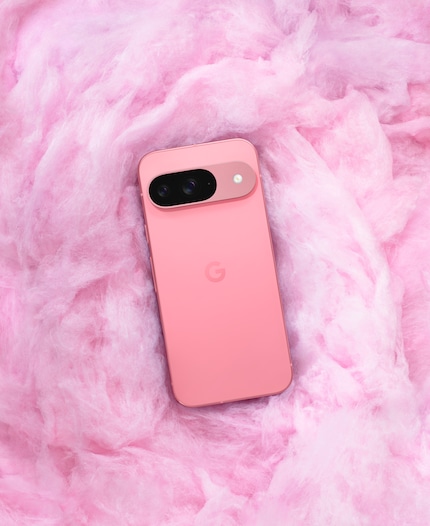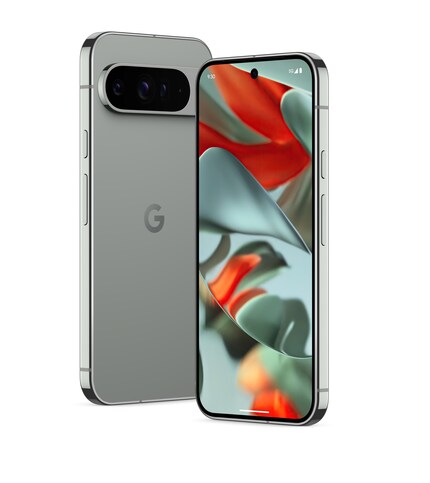
Product test
Pixel 8 Pro review: the telephoto camera won me over
by Jan Johannsen

The Pixel 9 series is here - and comes in three versions: Pixel 9, Pixel 9 Pro and Pixel 9 Pro XL. Google has customised the two Pro models even further so that you can choose your preferred screen size without any worries. Also in focus: AI assistant Gemini.
Google is "pixelating" early this year. The search engine specialists are already presenting their new phones in August. Google has given the Pixel 9 series its new chip, the Tensor G4, and worked intensively on the look. The Gemini AI assistant is also celebrating its eagerly awaited debut.
Google has also made other design changes. The back is now completely flat, as are the side edges, which now have a 90-degree edge instead of a rounded one. This should make the devices thinner than their predecessors. The brushed glass back is matt and less susceptible to fingerprints. Meanwhile, the camera attachment and the side edges have metal surfaces.
The new material makes the devices slightly heavier than their predecessors. The Pixel 9 weighs 198 grams, an increase of twelve grams. However, it is slightly wider than its predecessor, the Pixel 8: 1.2 millimetres wider and a whopping 2.3 millimetres taller. But, as mentioned, thinner: 8.5 millimetres instead of 8 millimetres. The same applies to the Pixel 9 Pro, which has the same dimensions as the Pixel 9.
Meanwhile, the differences between the Pixel 9 Pro XL and last year are minimal: the device only weighs eight grams more (new: 221 grams). It is also 0.2 millimetres larger, 0.1 millimetres wider and 0.3 millimetres thinner than its predecessor (162.8 × 76.6 × 8.5 mm). Google is therefore going back to the Pixel 7's diagnostic scale: 6.3 and 6.8 inches. This comes after the displays shrank by 0.1 inches last year.
The screens have also changed technically: Google states the peak brightness as 2700 nits, which should provide 35 per cent more brightness. This is a theoretical value; a precise test will bring clarity.
New colours have also been added: The Pixel 9 comes in Obsidian (black), Porcelain, Wintergreen and Peony (pink). The Pixel 9 Pros in Obsidian, Porcelain, Hazel, Rose and Quartz.
What the slightly larger displays do to the battery life is not yet clear. The battery capacities are similar to last year: 4700 mAh for the Pixel 9 and Pixel 9 Pro, 5060 mAh for the Pixel 9 Pro XL. However, they charge much faster. Up to 45 watts are now supported. This means they are still behind the "fast Chinese" from Oppo, Xiaomi and Co. but around twice as fast as last year. From 0 per cent to a 55 per cent charge level in 30 minutes, according to Google.
This year, Google's main focus was on the optical makeover and its AI assistant. This impression is confirmed by the lack of innovation in the camera hardwareLike its predecessor, the Pixel 9 is equipped with a 10.5-megapixel front camera with a ƒ/2.2 aperture and an ultra-wide-angle field of view of 95 degrees.
A wide-angle and an ultra-wide-angle camera are used on the back of the Pixel 9. The former is also supplied with 50 megapixels, an aperture size of ƒ/1.68 and a sensor size of 1/1.31". It also comes with an eightx zoom - albeit only 2x optical. This year, the ultra-wide-angle camera comes with an update that comes close to the specs of last year's Pro-Cam: 48 megapixels with autofocus, ƒ/1.7 aperture size and 1/2.55" image sensor.
The Pixel's own photo editing functions are also included again. The AI suggests the best shot for both photos and videos if you have photographed or filmed the subject several times. But you will also find the magic eraser, portrait lighting or subsequent sharpening again.
On paper, the video options also sound great: 8K recordings at 30 fps should be possible, or 4K at 60 fps - and 10-bit HDR is supported. You can zoom in up to 20x with the hybrid zoom - in video! Night vision mode and the audio eraser are also back.
Google is particularly proud when it announces that its AI assistant Gemini has made it onto the Pixel. You can activate it by clicking the on/off button. You can then let it write or plan something. Gemini can also help you search for information in your apps - for example, if you're looking for a departure time that's listed somewhere on a flight confirmation in your Gmail app. Or for details of an invitation you've received.
Cool: If you search for addresses on Google Maps, Gemini will also suggest suitable points along the way. For example, you can ask it to look for a flower shop that is still open on the way from you to the party mentioned. Or Gemini can suggest what you could conjure up for dinner from the pitiful leftovers in your fridge.
Google would like to point out that you can use the Google One AI Premium plan for free for a year when you buy a Pixel 9 Pro. You also get two terabytes of cloud storage on top. Everything remains the same when it comes to updates: you're on the safe side with the Pixel 9 for seven years.
The devices will be delivered from 21 August.
I've been tinkering with digital networks ever since I found out how to activate both telephone channels on the ISDN card for greater bandwidth. As for the analogue variety, I've been doing that since I learned to talk. Though Winterthur is my adoptive home city, my heart still bleeds red and blue.
From the latest iPhone to the return of 80s fashion. The editorial team will help you make sense of it all.
Show allThe visual differences compared to last year are clearly noticeable this year. Google has fundamentally overhauled the design. This is most evident on the back: the continuous "camera bar" of the Pixel 8 has disappeared. Instead, Google has opted for a slim, oval camera attachment that houses the lenses. Similar to the last year's Fold.


Google has invested in the Pixel 9 Pro series. The front camera already offers a full 42 megapixels, a ƒ/2.2 aperture and a 103-degree angle of view. Three cameras are used on the back. The star is the telephoto lens. It takes photos with 48 megapixels and 30x hybrid zoom (five times optical). The sensor size is 1/2.55". Also included are a 50 MP wide-angle camera (aperture: ƒ/1.68, image sensor 1/1.31") and a 48 MP ultra-wide-angle camera (aperture ƒ/1.7, image sensor 1/2.55")